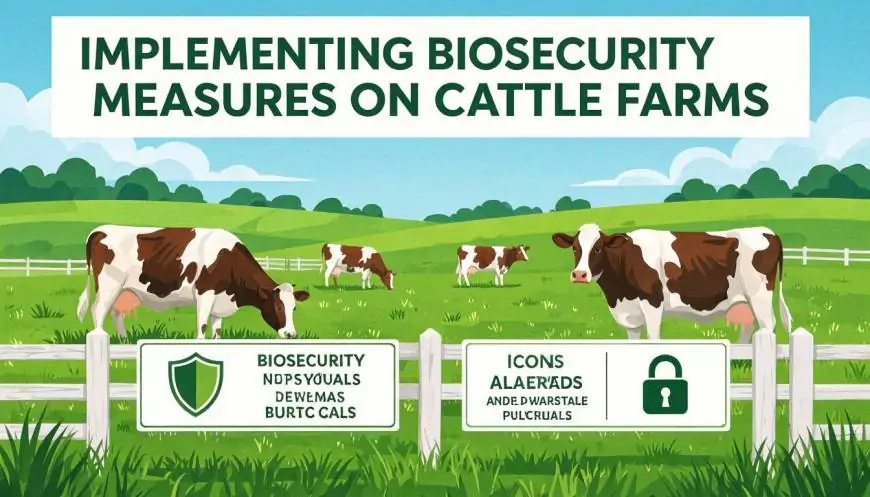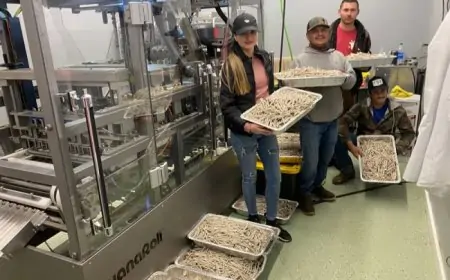The concept of biosecurity in the management of a successful cattle farm is a crucial one. It entails habits and traditions that are aimed at disallowing the emergence and dispersion of diseases that affect livestock, safeguarding animal health as well as farm output. Outbreaks of the diseases may lead to some serious economic losses, performance, and challenges in food safety. Having proper biosecurity will assist in guaranteeing that the cattle are healthy and the farming business as a whole will be sustainable.
Examples of the risks that farmers are exposed to are infectious agents through wildlife or contaminated equipment or people visiting farms. Identifying the origin and modes of disease transmission is the initial way of putting up protective measures. Through effective biosecurity management, farmers can ensure a good environment is maintained, and the capability of medical intervention cases is minimized, and the efficient reproduction and growth of animals in the form of cattle is enhanced.
Controlling Access To The Farm
Controlling access to the farm is one of the biosecurity procedures. Restricting access of people to the property and surveillance to their movements minimizes chances of bringing about pathogens. A strong cattle gate should be placed in the entry points so that the farmers could have control of the traffic going in and out of the premises and unauthorized persons could not enter. These rules can be further enforced through signage and proper visitors policy.
The guidelines to go by include cleaning of those footwear that people use, including veterinarians, contractors, and buyers to use disinfectant stations after and before touching cattle. Contamination can also be reduced with the provision of individual protection clothing/disposable coveralls. Having a good record of visitors is also important in trace movement, and taking timely action when out of disease fears.
Maintaining Cleanliness In Animal Housing And Feeding Areas
In places where the cattle grazes and forage, cleanliness is necessary to minimize the risk of exposure to the microorganisms that are harmful. Cattle troughs, feeding devices and water sources should be thoroughly cleaned and disinfected frequently thus eliminating known transmission factors of bacteria and viruses. Prevention of contaminants is done by avoiding the stagnant water and trough cleaning.
Animals should be placed in well-ventilated animal housing which should be dry in order to prevent the occurrence of mold and parasites. There is a high requirement of replenishing the bedding materials, and efficient manure management controls the spread of diseases. Keeping good sanitation habits will help make the environment less favourable to infection and will result in a generally healthy herd.
Quarantining New Or Returning Animals
There is plenty of risk of introducing disease when new cattle are brought into the herd. The introduction of new or returning animals should be separated in a special quarantine area, thus the animals are isolated from the main herd during a fixed time. This gives a chance to farmers to know their health conditions and to see whether they have some signs of illness so that these can be mixed with other animals.
It is advisable during quarantine to install separate feeding and watering apparatus as well as cattle troughs to avoid cases of cross contamination. Examination and investigation by vets at this time can help detect a problem as soon as possible. An adequate quarantine regime secures the current herd and can assist in the preservation of biosecurity on the farm.
Implementing Vaccination And Health Monitoring Programs
One of the biosecurity elements is vaccination to beef up the immunity of cattle against prevalent diseases. Outbreaks are minimized and less serious by a science-based, community-specific vaccination plan that accommodates the local risks and the herd requirements. A veterinarian will help in the use and application of the right vaccine at the correct time.
Regular health monitoring also plays a vital role. Monitoring the behavior, eating habits and the physical appearance enable farmers to identify the onset of disease early enough. The immediate isolation and care of diseased animals reduce the spread of the disease. Detailed health records facilitate the continued management of a herd and biosecurity of a herd.
Managing Equipment And Vehicles Carefully
Other site-specific technologies that can cause a disease outbreak include equipment and vehicles when not managed well. Grooming or feeding tools and medical tools must be disinfected and cleaned on a regular basis. Equipment within and across herds of cattle should not be shared to eliminate the risk of cross contamination.
Before the vehicles drive to the farm, the tires and undercarriages of the vehicles should be washed to eliminate dirt and organic matters. There is reduced traffic in the farm and creation of parking places that minimize contacts with livestock spaces. The hygiene of the equipment is another aspect of biosecurity that should not be overlooked and guards against the herd.
Training Farm Workers And Staff On Biosecurity
Biosecurity standards depend on farm workers and staff as those who should effectively operate them. This ensures that protocols are strictly adhered to by training them on the need to prevent diseases and the right hygiene practices. Biosecurity is front of mind when doing your daily tasks, through regular reminders and updates.
The attitude of responsibility and accountability will help to encourage the adherence to steps like wearing protective gear, washing hands, and disinfecting boots. Once all the people on the farm have a clear role to play in terms of biosecurity, introduction and spread of disease are greatly minimised.
Regularly Reviewing And Updating Biosecurity Practices
Biosecurity is not some effort that is made once, but it is a continuing process. The protocols that farmers should regularly examine should be intended to determine whether there are some areas that need to be improved or adjusted to new risks. This can be changing the signage, buying superior cleaning machines or changing the quarantine protocol.
Being updated on new infection and outbreaks in the region allows one to respond on time. Partnership with veterinarians and agricultural extension services are of great assistance. Through systematic assessment and improvement of biosecurity measures, farmers will be able to protect their cattle and thus the lasting prosperity of their business.








